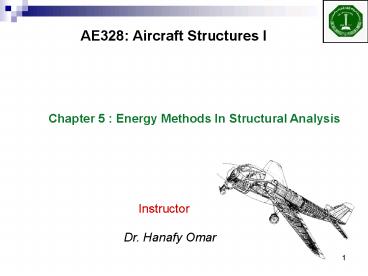AE328: Aircraft Structures I - PowerPoint PPT Presentation
1 / 12
Title:
AE328: Aircraft Structures I
Description:
For the shown rod, the work done by the applied force, WE= the change of the ... work done is stored in the deformed structures in the form of internal energy ... – PowerPoint PPT presentation
Number of Views:222
Avg rating:3.0/5.0
Title: AE328: Aircraft Structures I
1
AE328 Aircraft Structures I
Chapter 5 Energy Methods In Structural Analysis
Instructor
Dr. Hanafy Omar
2
Strain Energy
For the shown rod, the work done by the applied
force, WE the change of the energy associated
with the body ?E
Kinetic energy (T)
?E
Internal Energy (U)
If the loads are applied slowly, the kinetic
energy
Therefore, the work done the internal energy
In elastic structures, the work done is stored in
the deformed structures in the form of internal
energy called Strain Energy
3
Strain Energy and Complementary Energy
For the shown rod
Strain Energy Work done by the force
(1)
Which is represented by the area OBD under the
load-deflection curve
The area OBA above the curve is called
Complementary Energy (C)
(2)
It has no physical meaning
From (1) and (2), we get
4
Total Potential Energy
Total Potential Energy (TPE) is the sum of the
internal or strain energy and the potential
energy of the applied external forces
If we assume that the potential energy is zero in
the unloaded state (y0) , thus the loss of
potential energy of the load P as it produces a
deflection y is
The strain energy
5
Total Potential Energy
For a general system consisting of loads P1,
P2,Pn producing corresponding displacements ?1,
?2,.. ?n, the potential energy of all the loads is
Hence
6
Principle of Virtual Work
- Suppose that a particle is subjected to a system
of loads P1, P2,) - If we impose a small and imaginary displacement
i.e. Virtual Displacement, ??R in the direction
of PR, then from the law of conservation of
energy of
(Resultant)
At equilibrium PR0
Eq(8)
Eq (8) represents the Principle of virtual work
which can be stated as
A particle is in equilibrium under the action of
a force system if the total virtual work done by
the force system is zero for a small virtual
displacement.
7
Principle of Virtual Forces
- The elastic body shown is subjected to a system
of real loads which may be represented by P. Due
to P the body will be displaced such that points
1,2,. . . ,n move through displacements ?1 ?2,. .
., ?n.
Suppose that small imaginary loads ?PI, ?P2,. . .
, ?Pn were in position and acting in the
directions of ?1, ?2,. . ., ?n. before P was
applied since ? PI, ?P2,. . . , ? Pn , are
imaginary they will not affect the real
displacements. The total imaginary, or virtual
work ? W' done by these loads is then given by
Virtual Strain Energy
since
8
Principle of the stationary value of the total
potential energy
The total potential energy of an elastic system
has a stationary value for all small
displacements when the system is in equilibrium
further, the equilibrium is stable if the
stationary value is a minimum.
9
(No Transcript)
10
Principle of the stationary value of the total
potential energy
The total potential energy of an elastic system
has a stationary value for all small displacements
when the system is in equilibrium further, the
equilibrium is stable if the stationary value is
a minimum.
11
(No Transcript)
12
(No Transcript)

